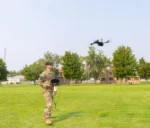Finnish radar satellite operator ICEYE has unveiled its fourth-generation synthetic aperture radar (SAR) satellite platform. The new design delivers significantly improved image resolution and area coverage—key enhancements aimed at boosting persistent surveillance for defense, disaster response, and commercial monitoring missions.
Gen4 Platform Overview: Doubling Down on Performance
The ICEYE Gen4 SAR platform marks a major leap in capability over previous iterations. According to the company’s official announcement on June 3, 2024, the new spacecraft offers:
- Sub-meter native resolution in spotlight imaging mode (reportedly better than 50 cm), enabling finer detection of tactical objects such as vehicles or small vessels.
- Doubled swath width in stripmap mode—now up to 240 km—allowing broader area coverage per pass without sacrificing revisit time.
- Improved onboard processing and downlink bandwidth to support faster tasking-to-delivery cycles.
The Gen4 system is designed for rapid deployment into low Earth orbit (LEO) as part of ICEYE’s growing constellation of commercial SAR satellites. The first Gen4 unit was launched aboard SpaceX’s Transporter-10 rideshare mission in March 2024. Initial imagery confirms the platform is fully operational.
SAR Imaging Enhancements for Tactical ISR
Synthetic aperture radar offers unique advantages for military intelligence, surveillance, and reconnaissance (ISR), particularly under conditions where electro-optical sensors are degraded—such as night operations or heavy cloud cover. The Gen4 platform’s sub-meter resolution enables analysts to distinguish between object classes like armored vehicles vs. civilian trucks or to detect changes in terrain indicative of fortification or movement.
The expanded swath width also enhances wide-area change detection and maritime domain awareness (MDA). For instance:
- A single pass can now monitor larger border zones or coastal regions without requiring multiple satellites or passes.
- Improved revisit rates across high-priority areas enable near-persistent coverage when integrated into a constellation model.
This makes the system well-suited for applications such as battlefield monitoring (e.g., tracking vehicle dispersal patterns), infrastructure damage assessment after strikes or disasters, and ship tracking in contested maritime zones.
Constellation Strategy and Defense Use Cases
ICEYE operates one of the largest commercial SAR constellations globally—with over two dozen satellites currently active—and aims to expand further with both commercial and government partners. The modularity of the Gen4 design allows it to be integrated seamlessly into existing orbital slots while offering backward compatibility with ICEYE’s ground segment infrastructure.
The company has already delivered dedicated satellites to several national governments under bespoke contracts. Notably:
- Ukraine received access to a dedicated ICEYE SAR satellite via a private donor-funded arrangement in 2022–2023; this asset has reportedly been used for real-time targeting support against Russian positions.
- The U.S. National Reconnaissance Office (NRO) awarded ICEYE a study contract under its Strategic Commercial Enhancements program in late 2023, exploring integration pathways into U.S. defense ISR architectures.
The Gen4 upgrade could further position ICEYE as a viable provider of tactical ISR capabilities for allied militaries seeking sovereign control over space-based sensing without building national space programs from scratch.
Technical Architecture and Payload Improvements
The Gen4 platform builds upon lessons learned from earlier generations by refining both hardware miniaturization and radar signal processing algorithms. Key technical features include:
- X-band radar payloads, optimized for high-resolution imaging at short wavelengths suitable for tactical object discrimination.
- Agile beam steering, allowing fast retasking between adjacent ground targets during a single orbital pass—a crucial requirement for time-sensitive ISR missions.
- Enhanced onboard storage capacity, enabling buffering of high-volume data until optimal downlink windows are available via ground stations or relay networks.
The spacecraft bus itself remains compact (<100 kg class), which supports cost-effective launch via rideshare missions while maintaining sufficient power generation through deployable solar arrays sized for continuous radar operation cycles.
Differentiation from Competitors in Commercial SAR Market
The commercial SAR market has grown increasingly competitive with players such as Capella Space (USA), Umbra Lab (USA), Synspective (Japan), and Airbus Defence & Space offering various levels of resolution and revisit frequency. However, ICEYE’s key differentiators include:
- A mature constellation already delivering operational data globally since 2018;
- A proven track record supporting both humanitarian missions (e.g., flood mapping) and military clients;
- An aggressive cadence of technology refresh cycles—Gen1 debuted in early 2018; Gen3 was operational by mid-2021; now Gen4 enters service less than three years later;
This rapid iteration cycle allows ICEYE to incorporate customer feedback swiftly while maintaining technological parity—or advantage—over slower-moving incumbents tied to legacy platforms or government procurement timelines.
Implications for Future Military Surveillance Architectures
The introduction of sub-meter resolution commercial SAR platforms like ICEYE’s Gen4 blurs traditional lines between strategic national assets and commercially accessible systems. For militaries lacking sovereign space capabilities—or those seeking redundancy against anti-satellite threats—the ability to lease dedicated satellites or task commercial constellations offers flexibility at scale.
If adopted widely by NATO members or Indo-Pacific partners facing contested domains (e.g., Taiwan Strait monitoring), platforms like Gen4 could serve as foundational elements within hybrid ISR architectures that blend military-owned assets with commercial feeds fused via AI-enhanced ground stations or C5ISR networks.
Outlook: Toward Real-Time Global Change Detection?
Looking ahead, ICEYE plans continued expansion toward near-real-time change detection across global hotspots using AI-aided analytics layered atop frequent revisit imagery. The company is investing in automated tipping-and-cueing workflows that would allow rapid identification of anomalous activity—from troop buildups to illegal deforestation—and immediate tasking of higher-resolution assets accordingly.
If successful at scale, this model could render traditional “snapshot” reconnaissance obsolete—replacing it with dynamic situational awareness updated hourly rather than daily or weekly intervals. The Gen4 satellite is a critical enabler toward that vision—not just an imaging sensor but part of an evolving ecosystem reshaping how Earth observation supports security decision-making globally.









